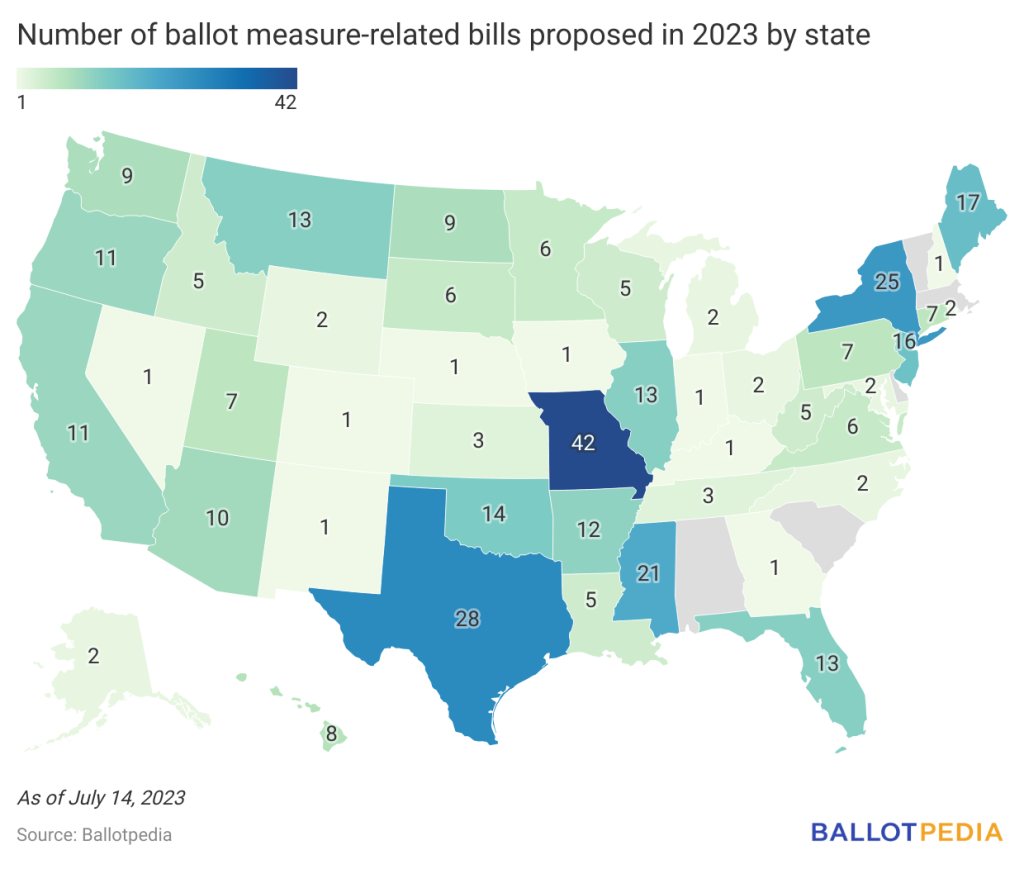Ohio Issue 1 would make several changes to the state’s citizen-initiated constitutional amendment process, including enacting a 60% vote threshold and expanding the signature distribution requirement. Issue 1, as a constitutional amendment, is on the ballot for voters to decide on Aug. 8. The Ohio State Legislature referred Issue 1 to the ballot on May 10, 2023. Legislators across 45 states have proposed at least 360 bills concerning ballot measures, initiatives, and recall elections in 2023. Issue 1 is one of 32 bills or resolutions related to ballot measures or recalls passed this year. As a constitutional amendment, voter approval is also required for Issue 1.
Bills that could make the initiative process more difficult
At least five bills passed in 2023 could make the ballot initiative process more difficult, which we define as policies that make campaigns more resource-intensive on average. You can review a list of these policies, examples, and an explanation of our classification system here.
Ohio Issue 1 meets this definition—an increased voter threshold, expanded distribution requirement, and elimination of the signature cure period—would make initiative campaigns more resource-intensive on average.
There are often competing ideas about a bill’s intent. While a bill’s sponsor could view a change as intended to increase rural representation or reduce out-of-state organizations from being involved in state politics, a bill’s opponent could view a change as undermining the ballot initiative process or designed to impede certain initiative campaigns.
- Regarding Issue 1, House Majority Whip Jim Hoops (R-81) said these changes would safeguard the Ohio Constitution “against hasty or impulsive changes that can lead to political turbulence” and “require a higher level of consensus and support.”
- Sarah Walker, Director of Policy and Legal Advocacy for the Ballot Initiative Strategy Center, said the proposed changes are “a direct attempt to limit what goes on the ballot, or what may be successful.”
Of the five bills that could make initiative processes more difficult, three are constitutional amendments, including Ohio Issue 1. As the initiative and referendum process is codified in state constitutions, constitutional amendments are often required to change certain aspects. While Issue 1 was placed on a special election ballot for Aug. 8, 2023, voters will decide on the other two amendments at the general election in November 2024.
- In Arizona, the state Legislature passed Senate Concurrent Resolution 1015, a constitutional amendment to create a signature distribution requirement for citizen-initiated ballot measures. Currently, Arizona does not have a signature distribution requirement. The ballot measure would require signatures from each of the state’s 30 legislative districts. SCR 1015 passed with unanimous support from legislative Republicans and unanimous opposition from legislative Democrats.
- In North Dakota, the state Legislature passed a constitutional amendment, Senate Concurrent Resolution 4013, to establish a single-subject rule for initiatives, increase the signature requirement for initiated constitutional amendments from 4% to 5% of the state’s population, and require that voters approve initiated constitutional amendments at two elections. SCR 4013 received support from 20% of legislative Democrats and 93% of legislative Republicans.
The remaining 29 bills enacted in 2023 were state statutes not requiring voter approval. The two other (non-constitutional) changes that could make initiative processes more difficult are Arkansas House Bill 1419 and Montana Senate Bill 93. Arkansas HB 1419 increased the signature distribution requirement for initiatives from 15 counties to 50 (of 75) counties. Montana SB 93 created a $3,700 filing fee for initiatives and prohibited people from proposing initiatives that were substantially the same as measures that had been defeated in the previous four years.
In 2023, two bills were passed that make the initiative process easier for campaigns. One of these changes, Arkansas Senate Bill 377, received unanimous bipartisan support, and the other bill, South Dakota Senate Bill 113, received support from Democrats and 92% of Republicans.
- Arkansas SB 377 criminalized certain interferences with initiative petitions and petitioners and required paid petition blockers, defined as persons or entities that pay people to interfere with a canvasser’s attempt to solicit or obtain a signature, to register with the state, and to undergo criminal history checks.
- After the U.S. 8th Circuit Court of Appeals ruled in SD Voice v. Noem that South Dakota’s initiative signature deadline of one year before the general election was unconstitutional, the South Dakota Legislature passed SB 113, changing the signature deadline to the first Tuesday in May of a general election year.
Changes to the ballot initiative process and partisanship
With Ohio Issue 1, no Democrats voted for the constitutional amendment. Most (94.6%) legislative Republicans did. Five House Republicans opposed the resolution that placed Issue 1 on the ballot.
Here’s the partisan vote difference for the other four bills and resolutions that could make initiative processes more difficult:
- Arizona SCR 1015: 100% of Republicans, 0% of Democrats;
- Montana SB 93: 100% of Republicans, 2.2% of Democrats;
- Arkansas HB 1419: 96.2% of Republicans, 0% of Democrats;
- North Dakota SCR 4013: 92.7% of Republicans, 20% of Democrats
Legislation about ballot measures is proposed across the U.S., including in states without a state initiative and referendum process. In New York, for example, there is no state initiative process, but 25 bills have been proposed, including bills related to local ballot measures, legislative constitutional amendments, and constitutional amendments to create an initiative process.
Missouri, which has an initiative process, has the most introduced bills for 2023 at 42, including 23 constitutional amendments to change the initiative process. One amendment, which received a vote in the House, would have required a 57% vote to pass constitutional amendments.

Here, we focus on the 26 states with an initiative or referendum process. Most bills were proposed and enacted in states where Republicans control the governor’s office and both chambers of the state legislature.
- Thirteen (13) of these states are Republican trifectas. A total of 147 bills were proposed and 21 were enacted. That’s an average of 11.31 proposed and 1.62 enacted per state.
- Ten (10) of these states are Democratic trifectas. A total of 67 bills were proposed and six were enacted. That’s an average of 6.7 proposed and 0.60 enacted per state.
- Three (3) of these states have divided governments. A total of 13 bills were proposed and one was enacted. That’s an average of 4.33 proposed and 0.33 enacted per state.
Both the five bills that could make the initiative process more difficult and the two bills that could make the initiative process easier were enacted in Republican trifecta states. Whereas the former passed with support from Republican majorities, the latter passed with support from most members of both parties.
There were several bills that passed with majorities from either Republicans or Democrats that weren’t related to making the initiative process easier or harder. In Montana, the Republican-controlled Legislature passed a bill allowing real property owners to submit a petition, signed by 20% or more of real property owners within a zoning district, for a ballot measure to terminate a zoning district. In Washington, the Democratic-controlled Legislature repealed the statewide advisory vote requirement for tax increases. Voters passed an initiative to create mandatory advisory votes in 2007.
Half (16 of 32) of the bills passed had support from Democratic and Republican majorities, and nine of those bills had unanimous support. Many of these bills enacted technical changes, but some could have noticeable effects on ballot measures. In North Dakota, for example, the Legislature passed Senate Bill 2163, which requires summaries of ballot measures to be written in “plain, clear, understandable language using words with common, everyday meaning.”
Trends with ballot measure legislation since 2018
During the first week of August, ahead of the vote on Ohio Issue 1, Ballotpedia plans to publish a report on ballot measure-related legislation from 2018 through 2023, how legislators have voted on these changes, and how legislation enacted over the past five years has affected the ballot initiative process.
Want to learn more about Ohio Issue 1? Check out Ballotpedia’s page on the constitutional amendment, and our previous articles on the upcoming vote:
- July 14: Ohio Issue 1 is the 270th proposed amendment to the Ohio Constitution since the 1912 constitutional convention
- July 13: Ohio Issue 1: How the proposed signature distribution requirement compares to other states
- July 12: Ohio Issue 1: Examining the 60% vote requirement within the context of other states and prior ballot measures
- July 11: Early voting on Ohio Issue 1, a ballot measure to change the vote and signature distribution requirements for amendments, begins Tue., July 11
Additional reading:


